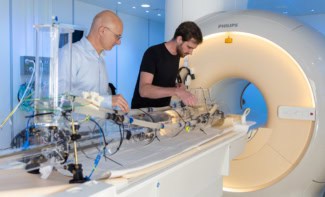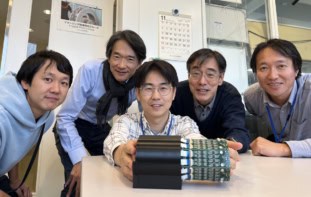David Scott outlines why we need physics to drive change in cancer research
Over the past 40 years significant strides have been made towards tackling cancer. During this relatively brief period, survival has doubled in the UK and 50% of people will now survive the disease for a decade or more. At the core of this progress is research, bringing advances in screening techniques, diagnostic tests and treatments that together are helping to transform the outlook for this disease.
Despite these developments, now is not the time for complacency. Progress has not been uniform and for several cancers, such as oesophageal and pancreatic, survival has lagged far behind and seen little improvement. And for most patients whose disease has spread, achieving a cure remains a distant prospect. To ensure advances continue rather than stagnate, there is a clear case for innovation in the way we approach and carry out cancer research.
That is why in 2015 Cancer Research UK launched the Grand Challenge – an ambitious £20m programme to support scientists to solve some of the greatest problems facing the field. The grants not only seek to overcome major obstacles that stand in the way of progress, but also challenge more traditional ways of working. Where the increasing competitiveness of research funding may have sparked a trend towards safety as opposed to innovation, Grand Challenge seeks to encourage bold thinking and reward novel ideas and approaches to research.
A worldwide approach
With the complexity and scale of the issues at hand, from unravelling disease biology to overcoming treatment toxicity, the programme is not exclusive to the UK but open to researchers worldwide – encouraging collaboration across an exceptional pool of international talent. But collaboration requires more than the sum of many minds.
To tackle such significant problems we need a breadth of knowledge and expertise. This is why Grand Challenge is designed for the physical and life sciences to come together, forging truly multidisciplinary teams that can bring forward and capitalise on the range of unique skills that each discipline offers. By breaking down both geographical and disciplinary barriers, Grand Challenge ultimately seeks to transform cancer research and to beat cancer sooner.
While cancer research may traditionally be placed among the life sciences, physics has been pivotal to some of the greatest advances in treatment and diagnosis to date. It was physicists who pioneered the field of radiology as far back as the 1800s. The serendipitous discovery of the X-ray, by German physicist Wilhelm Röntgen in 1895, triggered a global change in diagnostics virtually overnight, turning previously invisible maladies into diagrams of ill health.
And it was the subsequent surge of interest worldwide that soon identified another purpose for radiation in medicine: radiotherapy. Now a cornerstone treatment that has helped save millions of lives, radiotherapy has had a century of research and refinement to turn it into the incredibly sophisticated and precise technique that it is today. Yet the work is not over. As new technology allows the limits of what can be achieved to be pushed further and further – not just in these fields but across the board – opportunities arise to explore previously uncharted territories in cancer science, making now a more exciting time than ever to be involved.
The physics of cancer
The inaugural round of Grand Challenges resulted in four groups being funded. One winner was Josephine Bunch from the National Physical Laboratory, who was awarded a £16m grant to map tumours and get down to their metabolic nuts and bolts at the molecular and cellular level. Bunch and colleagues will use an array of new mass-spectrometry techniques, and other methodologies they have pioneered, to detail everything from whole tumours down to individual molecules within the cells that comprise them. This ambitious project will involve physicists, chemists, biologists and technology innovators who all bring their own unique skills. Hopefully it can spur new developments in treatment and diagnostics that could ultimately lead to more lives saved.
Seed funding
For the programme’s second round, eight new challenges are looking to be solved. These range from developing artificial intelligence to help detect cancer earlier to defining mechanistic rules for treatment combinations. Ten teams have been shortlisted, which have each been given £30,000 of seed funding to get their ideas off the ground. The winners will be announced later this year.
Though applications for the current round are now closed, the 14 challenges that have so far been set are compelling evidence that applicants for round three will be no less audacious. The stakes are high, but the rewards are even greater. We hope that more physicists will take this opportunity to lead groundbreaking science that will revolutionize the field of cancer science.
- Physics World published a special issue on the physics of cancer in July 2013




